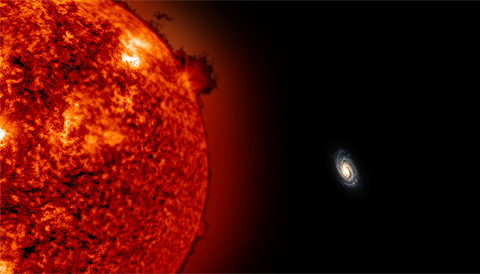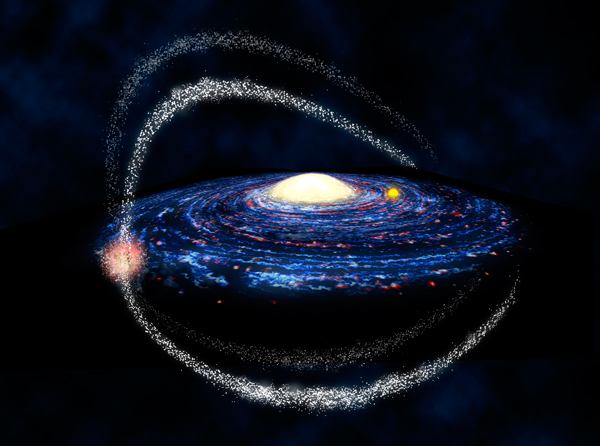Astronomy - Tracking Down the Milky Way’s Most Distant Stars
The most distant stars discovered in the Milky Way might have been ripped away from a companion galaxy.

This illustration demonstrates how small the Milky Way would look from the location of ULAS J0744+25, a red giant star nearly 775,000 light-years away.
Visualization Software: Uniview by SCISS; Data: SOHO (ESA & NASA) / John Bochanski (Haverford College) / Jackie Faherty (AMNH and Carnegie Institute's Department of Terrestrial Magnetism)
Visualization Software: Uniview by SCISS; Data: SOHO (ESA & NASA) / John Bochanski (Haverford College) / Jackie Faherty (AMNH and Carnegie Institute's Department of Terrestrial Magnetism)
Over the last decade, multiple groups of astronomers have identified luminous stars more than 300,000 light-years from Earth. I was fortunate enough to discover the most distant of these stars, cool red giants that are almost 900,000 light-years away — the most distant stars that are still bound to our galaxy. (The galaxy's stellar disk, for comparison, is only 100,000 light-years across. Our galaxy's dark matter halo extends up to ten times farther, out to 1 million light-years.)
When my group at Rider University first published our findings, we speculated on just how those stars could have gotten so far away. Perhaps a gravitational interaction had ejected them from the Milky Way’s disk, maybe they were the brightest members of a dark companion dwarf galaxy, or they could even the remnants of a long-forgotten galaxy shredded by the Milky Way’s gravity.
Now, in a result accepted for publication in the Astrophysical Journal (available online here), Marion Dierickx and Avi Loeb (both at Harvard University) argue that the last scenario seems most likely: some of these stars are probably members of what was once the Sagittarius dwarf galaxy.

This artist's impression shows the tidal tails of stars (white) streaming from the Sagittarius Dwarf Galaxy (orange) that orbits the Milky Way. The bright yellow circle to the right of the galaxy's center is our Sun (not to scale). Sagittarius is on the other side of the galaxy from us, but we can see its tidal tails of stars stretching across the sky as they wrap around our galaxy.
Amanda Smith / University of Cambridge
Amanda Smith / University of Cambridge
Sagittarius is the best-studied dwarf galaxy remnant in our galaxy. This small galaxy passes close by the Milky Way in its orbit and every time it sweeps by, it sheds stars. The streams of stars loop around our galaxy in majestic curves that crisscross over the sky. Steve Majewski and collaborators first mapped the galaxy’s remnants using cool red giants identified in 2MASS observations. Further observations using the Sloan Digital Sky Survey refined the position, distances, and velocities of these stars.
Starting with these maps, Dierickx and Loeb wound the computational clock backwards to more than 8 billion years ago, when Sagittarius would first have started interacting with the Milky Way. Then they varied the initial velocity and direction of the dwarf galaxy in their simulation. "The starting speed and approach angle have a big effect on the orbit, just like the speed and angle of a missile launch affects its trajectory," Loeb explains. Watch the animation here.
Then they let the simulations run and compared their results to the 11 most distant stars identified in the Milky Way. Five of these stars matched the positions, velocities, and distances expected for Sagittarius members at very large distances. The other six might be members of another former dwarf galaxy, but this is less certain.
"More interlopers from Sagittarius are out there just waiting to be found," Dierickx says.
As a researcher searching for distant stars, I find the work by Dierickx and Loeb to be very exciting. It confirms the existence of these stars at large distances, and it gives observers a map to finding more. I hope that we will have many more stellar discoveries in the coming years.
No comments:
Post a Comment